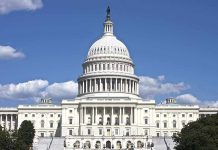
One celebrity in a pair of jeans ignited a national debate, exposing just how combustible America’s culture wars have become—even when the message, according to the star at the center, was never meant to be political at all.
Story Snapshot
- The American Eagle ad featuring Sydney Sweeney became a lightning rod for political controversy in October 2025.
- Public backlash centered on perceived political undertones and alleged links to Donald Trump’s support base.
- Sweeney publicly clarified her stance, emphasizing the ad’s creative intent and distancing herself from political endorsements.
- The episode highlights the deep polarization surrounding celebrity endorsements in modern advertising.
How a Denim Campaign Became a Political Battleground
American Eagle’s October 2025 launch of its latest campaign featuring Sydney Sweeney was meant to target Gen Z shoppers with youthful optimism and mainstream appeal. Instead, the ad turned into a cultural flashpoint. Social media critics quickly seized on visual cues and messaging they claimed echoed American political themes, particularly those associated with Donald Trump’s base. The reaction snowballed through viral posts, morphing creative direction into a referendum on political values. By late October, major media outlets and political commentators had joined the fray, transforming a standard retail campaign into a headline-dominating controversy.
Sydney Sweeney breaks silence on controversial American Eagle ad, addresses Donald Trump’s support https://t.co/cJ57bYYzQm pic.twitter.com/YE8OhMX2PZ
— Page Six (@PageSix) November 4, 2025
Brands like American Eagle routinely use celebrities to build credibility with younger audiences, but the rules have changed. In today’s hyper-polarized climate, even the appearance of political symbolism can provoke a backlash. Sweeney, whose star has risen rapidly in Hollywood, became the focal point not just of fashion chatter but of partisan debate. The campaign’s ambiguous creative decisions—colors, slogans, and styling—were interpreted by some as coded political endorsements, though no such intent was ever explicit. What followed was a case study in how quickly cultural narratives can spiral beyond anyone’s original intentions.
Sweeney Speaks and the Narrative Shifts
Facing mounting media pressure and a social media firestorm, Sydney Sweeney released a public statement in early November. She addressed the controversy directly, clarifying that the ad was never designed as a political statement and that she does not endorse Donald Trump. Her response was measured, transparent, and designed to halt speculation about her personal politics. Some industry analysts praised her for facing the issue head-on, while critics argued her clarification did little to quell the debate. American Eagle, for its part, reiterated its commitment to inclusivity and creative expression, but stopped short of a formal apology.
Public reaction to Sweeney’s statement remained mixed. While many supporters applauded her candor, others continued to dissect both her words and the ad’s imagery for hidden meanings. The campaign’s controversy persisted as a talking point across entertainment news and marketing forums, reflecting the enduring power of perception in the digital age. No major boycotts or formal repercussions for American Eagle surfaced, but the brand and its star had been indelibly marked by the episode.
Lessons for Brands and Public Figures in the Age of Polarization
The Sweeney-American Eagle saga offers a cautionary tale for brands navigating the fractured cultural landscape. Ambiguous creative decisions, even when innocent, can be weaponized by online audiences hungry for political meaning. Experts in crisis communication stress the value of swift, transparent responses, as Sweeney demonstrated. Marketing analysts point out the risks of failing to anticipate how creative choices might be interpreted in an era where everything is scrutinized through a political lens.
For celebrities, the incident underscores the challenge of maintaining a public persona amid competing narratives. Sweeney’s experience illustrates how quickly a career-defining moment—intended to be about jeans and self-expression—can morph into a national conversation about values and allegiances. For brands, it’s a reminder that creative freedom comes with risk, and that vetting campaigns for unintended political overtones has become an essential part of risk management. In the long run, the ad’s fallout may prompt both advertisers and stars to collaborate more closely on messaging, anticipating not just what they want to say, but how the world will hear it.
Sources:
AdSkate, “Sydney Sweeney American Eagle Ad: Backlash and Lessons”



